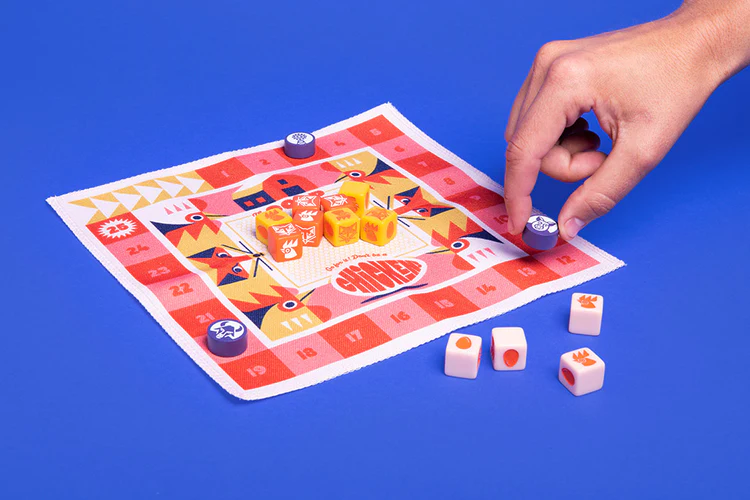To Be (Chicken) or Not To Be (Chicken)
Chicken! does not pretend to be anything other than what it says on the tin. The game comes in a small cylindrical tube adorned with artwork of foxes, chickens, farmers, and eggs. That’s pretty much the whole experience. In the game, players roll dice on each turn and can press their luck to score the most points (see: chickens). The first player to reach 25 points is the winner. It’s a fairly straightforward concept.
On your turn, players are passed some number of dice and must roll them all. You set aside any chickens or foxes you roll, leaving you with some blank dice or eggs. For every egg you roll, you must “hatch” (add) a die to your pool from the middle of the board. You then have the option to reroll all non-chicken, non-fox dice to press your luck. The catch, of course, is that if you ever roll three foxes, the foxes have raided the henhouse, and your turn is over, scoring zero points.

To mitigate this risk, Chicken! offers each player the opportunity to, well, “chicken out.” At the start of your turn, you can take a one-point penalty. If you do, you can reset the dice pool to the starting four dice, significantly decreasing your chances of rolling the dreaded three foxes. Of course, the game eggs (ha!) you on by prodding and teasing you, telling you not to be a chicken. It has all the elegance of a schoolyard taunt, but at the same time, when the other players at the table are daring you to roll those dice, it is shockingly effective at making you make poor decisions.
Press Your Cluck
The components of Chicken! are simple but effective. The game comes in a tube, as mentioned above. Turning it over and dumping out the contents reveals the treasures inside: a small one-page rulebook, 12 dice, a cloth game board for keeping score, and small wooden pieces for score tracking. Those player pieces feature artwork similar to the outside of the game’s storage tube and are similarly fanciful. Players can be a farmer, a cat, or a poop emoji, among other silly things. The whimsy is the point. The game intentionally comes across as a tad bit ridiculous.
The crux of the game comes from the dice. The dice pool starts with four white dice. These dice have only one chance to appear on the fox face, meaning they’re safer to roll. They also have more eggs, meaning you’ll add the yellow dice from the middle pool. The yellow dice have only one fox result but have more opportunities to roll chickens. However, after adding all yellow dice to the pool, you must add orange dice to the pool when you roll an egg. The orange dice have double the chances of showing up as a fox or totally blank, but the reward is higher, with a potential double chicken side rewarding you two points instead of one. The slow escalation into higher risk with higher reward makes the game so fun, and if you take the risk and let loose the foxes, then the yolk’s on you.

The biggest stroke of genius here is that you’re also pushing your opponent’s luck by pressing your luck. The more dice you add to the pool, the higher the risk is for your opponent to hit three foxes and bust for the turn. After all, players are not required to take the optional re-roll, and many times, the optimal play is to roll once, add in the new dice, and pass a big stack of 12 dice to your opponent and watch them sweat. If I had to make one complaint, it’d be that there isn’t enough appeal in taking the “chicken out” option and going down to four white dice. For players only a couple of points away from victory, it makes sense not to risk bricking completely and rolling safer. But it makes no sense to try chicken out for pretty much everyone else. Losing one point to roll four dice doesn’t feel great, especially when you have just as much chance of hitting eggs to add to the dice pool as hitting chickens to score. In the best-case scenario, you’re losing one point to score four.
In most cases, you’ll wind up going even or coming out ahead by one measly little point and add some helpful yellow dice to the pool for the next person to roll and reap the benefit. Plus, come on–rolling dice is fun! It feels excellent to roll 12 big, chunky dice and watch what happens. Why would you ever choose the less fun option? Because you want to win? That’s boring!
One-Chick Pony
Don’t let my nitpicking about the chickening out confuse you. It doesn’t matter. This game is just a blast. If you’re breaking this one out to try to have a deep, competitive experience with carefully calculated decisions based on probabilities and odds, you’re looking at the wrong game. Chicken! cares not for your puny desires for strategy or deep thought. It asks only one thing of you: don’t chicken out. Roll those dice. What could possibly go wrong?

I’m someone who hates randomness in most of my games, but Chicken! isn’t just any game. It’s Chicken!. It’s a game about rolling 12 dice against every strategic instinct in your brain telling you not to do it because, duh, of course you’re going to do it! It’s a game where everyone at the table shouts when you beat the odds to score big and laughs when you roll three foxes on four white dice. I mean, seriously? Two turns in a row? Three foxes on four white dice? What are the odds? (Author’s note: don’t actually tell me the odds. I don’t care. I’m rolling those dice.)
This party game makes simplicity its whole identity and runs with it. If someone doesn’t know how to play, you simply put dice in their hand and tell them to roll. People catch on fast. It scales up to eight players and keeps a quick pace. Waiting for people to arrive? Why not throw some dice? It speaks volumes that even after our tenth game of Chicken!, sprinkled between much larger games, people were still laughing and shouting “Chicken!” at the top of their lungs every time they rolled. Several people from my game group even rushed to buy their own copy to have it on standby when the situation called for it. You’re not getting some deep experience with this one, but hey, it’s not trying to be that. It’s trying to be Chicken!, and in that regard, it’s im-peck-able.












Add Comment